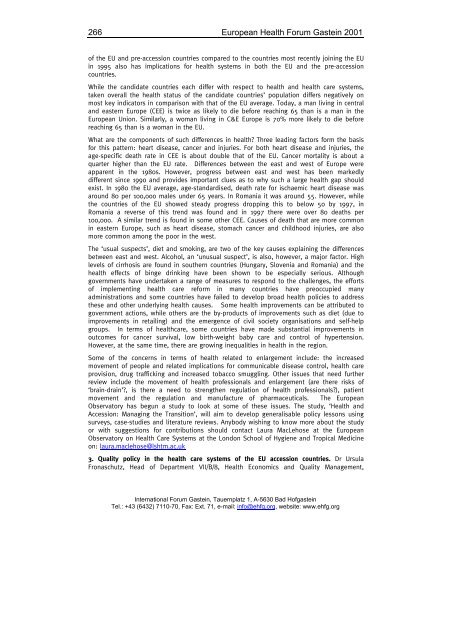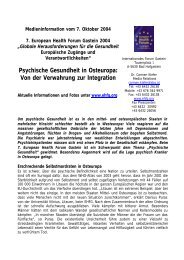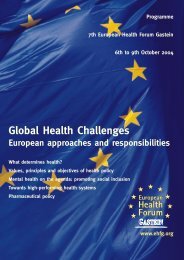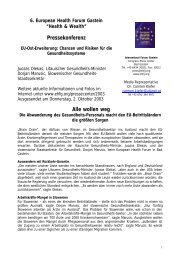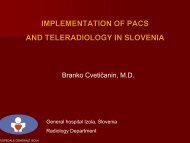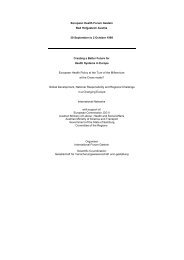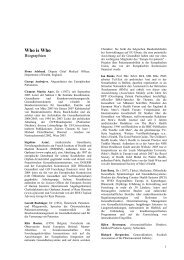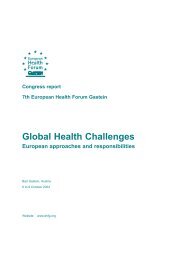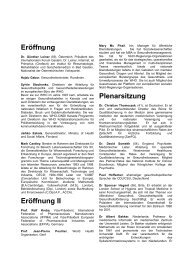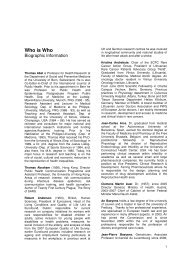Congress report - European Health Forum Gastein
Congress report - European Health Forum Gastein
Congress report - European Health Forum Gastein
Create successful ePaper yourself
Turn your PDF publications into a flip-book with our unique Google optimized e-Paper software.
266<br />
<strong>European</strong> <strong>Health</strong> <strong>Forum</strong> <strong>Gastein</strong> 2001<br />
of the EU and pre-accession countries compared to the countries most recently joining the EU<br />
in 1995 also has implications for health systems in both the EU and the pre-accession<br />
countries.<br />
While the candidate countries each differ with respect to health and health care systems,<br />
taken overall the health status of the candidate countries’ population differs negatively on<br />
most key indicators in comparison with that of the EU average. Today, a man living in central<br />
and eastern Europe (CEE) is twice as likely to die before reaching 65 than is a man in the<br />
<strong>European</strong> Union. Similarly, a woman living in C&E Europe is 70% more likely to die before<br />
reaching 65 than is a woman in the EU.<br />
What are the components of such differences in health? Three leading factors form the basis<br />
for this pattern: heart disease, cancer and injuries. For both heart disease and injuries, the<br />
age-specific death rate in CEE is about double that of the EU. Cancer mortality is about a<br />
quarter higher than the EU rate. Differences between the east and west of Europe were<br />
apparent in the 1980s. However, progress between east and west has been markedly<br />
different since 1990 and provides important clues as to why such a large health gap should<br />
exist. In 1980 the EU average, age-standardised, death rate for ischaemic heart disease was<br />
around 80 per 100,000 males under 65 years. In Romania it was around 55. However, while<br />
the countries of the EU showed steady progress dropping this to below 50 by 1997, in<br />
Romania a reverse of this trend was found and in 1997 there were over 80 deaths per<br />
100,000. A similar trend is found in some other CEE. Causes of death that are more common<br />
in eastern Europe, such as heart disease, stomach cancer and childhood injuries, are also<br />
more common among the poor in the west.<br />
The ‘usual suspects’, diet and smoking, are two of the key causes explaining the differences<br />
between east and west. Alcohol, an ‘unusual suspect’, is also, however, a major factor. High<br />
levels of cirrhosis are found in southern countries (Hungary, Slovenia and Romania) and the<br />
health effects of binge drinking have been shown to be especially serious. Although<br />
governments have undertaken a range of measures to respond to the challenges, the efforts<br />
of implementing health care reform in many countries have preoccupied many<br />
administrations and some countries have failed to develop broad health policies to address<br />
these and other underlying health causes. Some health improvements can be attributed to<br />
government actions, while others are the by-products of improvements such as diet (due to<br />
improvements in retailing) and the emergence of civil society organisations and self-help<br />
groups. In terms of healthcare, some countries have made substantial improvements in<br />
outcomes for cancer survival, low birth-weight baby care and control of hypertension.<br />
However, at the same time, there are growing inequalities in health in the region.<br />
Some of the concerns in terms of health related to enlargement include: the increased<br />
movement of people and related implications for communicable disease control, health care<br />
provision, drug trafficking and increased tobacco smuggling. Other issues that need further<br />
review include the movement of health professionals and enlargement (are there risks of<br />
‘brain-drain’?, is there a need to strengthen regulation of health professionals?), patient<br />
movement and the regulation and manufacture of pharmaceuticals. The <strong>European</strong><br />
Observatory has begun a study to look at some of these issues. The study, ‘<strong>Health</strong> and<br />
Accession: Managing the Transition’, will aim to develop generalisable policy lessons using<br />
surveys, case-studies and literature reviews. Anybody wishing to know more about the study<br />
or with suggestions for contributions should contact Laura MacLehose at the <strong>European</strong><br />
Observatory on <strong>Health</strong> Care Systems at the London School of Hygiene and Tropical Medicine<br />
on: laura.maclehose@lshtm.ac.uk<br />
3. Quality policy in the health care systems of the EU accession countries. Dr Ursula<br />
Fronaschutz, Head of Department VII/B/8, <strong>Health</strong> Economics and Quality Management,<br />
International <strong>Forum</strong> <strong>Gastein</strong>, Tauernplatz 1, A-5630 Bad Hofgastein<br />
Tel.: +43 (6432) 7110-70, Fax: Ext. 71, e-mail: info@ehfg.org, website: www.ehfg.org


